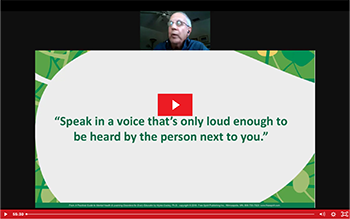Why It’s Important for Teachers to Recognize and Understand Student Mental Health Challenges
Based on the statistics about mental health in America, every classroom has students facing mental health difficulties. This article for teachers explores the behavior implications of these numbers and takes a closer look at some of the common mental health disorders that teachers encounter in classroom. It also proposes some practical tips to address discipline challenges at school.
Mental Health Challenges by the Numbers
There are lots of students with mental health challenges in your classrooms. Let’s look at the numbers regarding student mental health
- Twenty percent of students have a diagnosable mental health disorder.1 Many more have mental health difficulties that don’t rise to the level of a diagnosis. Most of these students are in regular education classes.
- Many of these students cause behavior problems. Rates of expulsion and suspension are three times higher among students with mental health disorders.2
- There are not nearly enough school psychologists, counselors, or social workers to assist teachers with these students. The numbers of these professionals in schools fall well below levels recommended by their national associations.3
- Teachers get training in CPR, peanut allergies, and shooter drills, but no training in student mental health problems.
In recent years, student mental health challenges have accelerated. The numbers of students with depression, anxiety, loneliness, and grief4 have increased. The number of students eleven through seventeen years old screened for depression and anxiety was nine percent higher in 2020 than in 2019. Jen Vorse Wilka, president of YouthTruth, says, “Feeling depressed, stressed, or anxious is now the No. 1 obstacle to students’ learning”5
Understanding Mental Health Challenges
It is crucially important for teachers to recognize and understand how to work with student mental health challenges. It is vital for teachers to identify and help these students, because understanding specific student behavior is the beginning of resolving the issues surrounding mental health. An informed teacher is a point person to successfully respond to problems and appropriately teach students how to manage their mental health. Here are some examples:
ADHD
If you believe, as many do, that ADHD is simply a problem with concentration and/or impulsivity/hyperactivity, you won’t understand that these students also have weaknesses in executive functions. These are problems with starting and finishing classwork and homework, sustaining attention, organization, planning, transitioning, and working memory.
Working memory is holding information in your mind while you do something else, and then recalling the information. This executive function can cause problems in all academic subjects. In five-year-olds, working memory is more predictive than IQ is for future academic success.6
Executive function problems are a part of the disability known as ADHD and should not be penalized, but rather accommodated. For example, a student who doesn’t complete classwork due to slow processing speed or off-task behavior associated with ADHD should not be kept in at recess to complete that work. An appropriate accommodation might be reduced classwork.
 Oppositional Behavior
Oppositional Behavior
Not all oppositional behavior represents intentional defiance. For example, students who resist participating or speaking in front of the class may have social anxiety. Other students who are depressed may act out with misbehavior. Some students have little control or predictability in their lives. Helping students who feel out of control to have some autonomy and decision-making ability in the classroom is often useful. Creating smooth transitions is helpful. The oppositional behaviors can be addressed with supports specific to the needs of the individual student.
Autism Spectrum Disorder
These students may need you to be very specific with your language because they interpret instructions very literally. For example, when you’re preparing to go to the cafeteria and you say, “Line up,” autistic students may be confused because they think you’re talking about some line that goes up. The first few times you give this direction, it will be helpful if you’re explicit: “Class, we’re going to line up now. That means all of you will go over to the wall and stand in a line. Each of you will be in front of and behind of another student.” In the future when you say, “Line up,” autistic students will understand.
Learning what aspects of classroom settings can be stressful or triggering for autistic students can be valuable for teachers to keep all class members calm. A deep awareness of student needs will help teachers to watch out for and anticipate potential triggers that may occur and to prevent behavior from spiraling. Student mental health issues can be mitigated and decreased with awareness from staff.
Self-Harm
Students who engage in self-harm (cutting) will usually cover marks on their wrists and arms. Certainly, this is not likely the case for most students who wear long sleeves in hot weather, but it should arouse your suspicion and you should be aware that self-harm is a possibility. You are obligated to inform your students’ parents or guardians if you verify self-harm behavior.
Discipline
Regardless of student mental health, arguably the most difficult students for teachers are those who misbehave. A relatively new philosophy and practice for discipline in school or at home is based on the assumption that the goal of discipline is to teach.7 What’s wrong with older approaches to discipline?
Rewards and punishments don’t teach. Time-outs don’t teach. They isolate and reject children. The newer approach is based on the following ideas.
- Kids do well if they can. Most problematic behavior is due to lagging skills.8
- Kids know what to do, but they can’t do what they don’t know.9
- Most misbehavior is more about “can’t” than “won’t.” 10
- Every time kids misbehave, they give us a chance to know what they need help with throughout the learning process.11
What should teachers do instead?12
- Connect with the child with a calm expression and voice.
- Define the problem as an observation. (“I noticed you just pushed Felix.”)
- Do not ask “why.”
- Stop talking and listen.
- Validate how child feels.
- Tell the student how the behavior affects others.
- Invite the student to a later discussion to find alternatives to the misbehavior. Ross Greene calls this procedure “collaborative problem-solving.” You can read about this in his books: Raising Human Beings: Creating a Collaborative Partnership with Your Child and Lost and Found: Helping Behaviorally Challenged Students.
- Incorporate positive reinforcement with clear and specific praise and rewards for the behaviors you want to see students exhibiting.
Teachers, you have a really challenging job. Your primary role is to teach. We know that student mental health is a rising problem. We also know that if students are not okay emotionally, they can’t learn effectively. So, although recognizing, understanding, accommodating, and intervening with these students is one more additional task for you, it will help your students learn what you’re trying to teach. Although teachers are not mental health practitioners, they are the “eyes and ears” of mental health.13
1. Cooley, Myles. 2018. A Practical Guide to Mental Health and Learning Disorders for Every Educator. Minneapolis, MN: Free Spirit, 2.
2. Cooley 2018, 2.
3. Cooley 2018, 2.
4. Clopton, Jennifer. 2021. “Students Try to Cope As Pandemic Strains Mental Health.” WEBMD News. com/lung/news/20210324/students-try-to-cope-as-pandemic-strains-mental-health.
5. Wong, Alia. 2021. “Students Crushed by Stress, Depression Are Back in Class. Here’s How Schools Meet Their Needs.” USA Today. usatoday.com/in-depth/news/education/2021/04/11/the-ongoing-student-mental-health-crisis/4833824001.
6. Alloway, Tracy Packiam, and Ross G. Alloway. 2010. “Investigating the Predictive Roles of Working Memory and IQ in Academic Attainment.” Journal of Experimental Child Psychology. 106 (1): 20–29. pubmed.ncbi.nlm.nih.gov/20018296.
7, Siegel, Dan, and Tina Bryson. 2016. No-Drama Discipline: The Whole-Brain Way to Calm the Chaos and Nurture Your Child's Developing Mind. New York: Bantam.
8. Greene, Ross. 2014. Lost at School: Why Our Kids with Behavioral Challenges are Falling Through the Cracks and How We Can Help Them. New York: Scribner.
9. Barkley, Russell A., ed. 2018. Attention Deficit Hyperactivity Disorder: A Handbook for Diagnosis and Treatment, Fourth Edition. New York: Guilford Press.
10. Siegel and Bryson 2016.
11. Siegel and Bryson 2016.
12. Siegel and Bryson 2016; Greene 2014.
13. Wong 2021.
Author Bio:
View All AuthorsMyles L. Cooley, Ph.D., Author
Myles L. Cooley, Ph.D., has been practicing psychology for over thirty years. He evaluates and treats children, adolescents, and adults for a variety of problems. Dr. Cooley serves as a consultant to schools and has presented educational programs to educators, mental health professionals, physicians, and parents.
Join the Free Spirit Publishing Blog Community
Subscribe by sharing your email address and we will share new posts, helpful resources and special offers on the issues and topics that matter to you and the children and teens you support.

